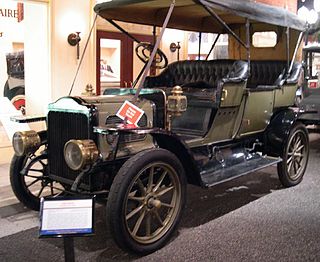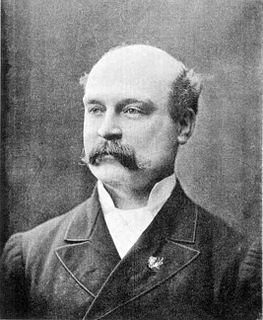
The Tarrant automobile was the first motor car built in Victoria, Australia and the first petrol engine motor car built in Australia.

The Tarrant automobile was the first motor car built in Victoria, Australia and the first petrol engine motor car built in Australia.
Colonel Harley Tarrant built his first car in 1901. After a small number of motor vehicles were built, it became apparent that it was uneconomic to build indigenous vehicles, in the face of overseas technology. Tarrant assumed the responsibility for distribution of Ford automobiles in Victoria in 1908, and production of Tarrants ceased. The Tarrant automobile was a 2 cylinder vehicle and contained only 2 seats; the driver and the passenger.
About 16 cars were built between 1900 and 1907. [1]
The last surviving Tarrant was acquired by the Royal Automobile Club of Victoria in 2002. [1]
In 1984 the car was featured on a postage stamp, part of a series of five depicting early Australian automobiles, issued by Australia Post .

General Motors Company (GM) is an American automotive multinational corporation headquartered in Detroit, Michigan, United States. It was founded by William C. Durant on September 16, 1908, as a holding company, and the present entity was established in 2009 after its restructuring. The company is the largest American automobile manufacturer and one of the world's largest automobile manufacturers.

The Cadillac Motor Car Division is a division of the American automobile manufacturer General Motors Company (GM) that designs and builds luxury vehicles. Its major markets are the United States, Canada, and China. Cadillac models are distributed in 34 additional markets worldwide. Cadillac automobiles are at the top of the luxury field within the United States. In 2019, Cadillac sold 390,458 vehicles worldwide, a record for the brand.

McLaughlin Motor Car Company Limited was a Canadian manufacturer of automobiles headquartered in Oshawa, Ontario. The company, founded by Robert McLaughlin, once was the largest carriage manufacturing factory in the British Empire. By 1907 it had grown to include the manufacture of McLaughlin automobiles with Buick engines and in 1915, it manufactured Chevrolet vehicles for the US and Canadian market. The carriage end of the business was then sold to the Carriage Factories Ltd. of Orillia, Ontario.

Rambler is an automobile brand name that was first used by the Thomas B. Jeffery Company between 1900 and 1914.

Studebaker was an American wagon and automobile manufacturer based in South Bend, Indiana. Founded in 1852 and incorporated in 1868 as the Studebaker Brothers Manufacturing Company, the firm was originally a coachbuilder, manufacturing wagons, buggies, carriages and harnesses.

Nash Motors Company was an American automobile manufacturer based in Kenosha, Wisconsin, in the United States from 1916 to 1937. From 1937 to 1954, Nash Motors was the automotive division of the Nash-Kelvinator Corporation. Nash production continued from 1954 to 1957 after the creation of American Motors Corporation.

The Hudson Motor Car Company made Hudson and other branded automobiles in Detroit, Michigan, U.S., from 1909 to 1954. In 1954, Hudson merged with Nash-Kelvinator to form American Motors Corporation (AMC). The Hudson name was continued through the 1957 model year, after which it was discontinued.

An antique car is an automobile that is an antique. Narrower definitions vary based on how old a car must be to qualify. The Antique Automobile Club of America defines an antique car as over 25 years of age. However, the legal definitions for the purpose of antique vehicle registration vary widely. The antique car era includes the Veteran era, the Brass era, and the Vintage era, which range from the beginning of the automobile up to the 1930s. Later cars are often described as classic cars. In original or originally restored condition antiques are very valuable and are usually either protected and stored or exhibited in car shows but are very rarely driven.
The automotive aftermarket is the secondary market of the automotive industry, concerned with the manufacturing, remanufacturing, distribution, retailing, and installation of all vehicle parts, chemicals, equipment, and accessories, after the sale of the automobile by the original equipment manufacturer (OEM) to the consumer. The parts, accessories, etc. for sale may or may not be manufactured by the OEM. According to a report by the International Trade Administration in the US Department of Commerce, "Aftermarket parts are divided into two categories: replacement parts and accessories. Replacement parts are automotive parts built or remanufactured to replace OE parts as they become worn or damaged. Accessories are parts made for comfort, convenience, performance, safety, or customization, and are designed for add-on after the original sale of the motor vehicle."

The Terraplane was a car brand and model built by the Hudson Motor Car Company of Detroit, Michigan, between 1932 and 1938. In its maiden year, the car was branded as the Essex-Terraplane; in 1934 the car became simply the Terraplane. They were inexpensive, yet powerful vehicles that were used in both town and country. The Terraplane name was used for both cars and trucks.

A steam car is a car (automobile) propelled by a steam engine. A steam engine is an external combustion engine (ECE) in which the fuel is combusted outside of the engine, unlike an internal combustion engine (ICE) in which fuel is combusted inside the engine. ECEs have a lower thermal efficiency, but carbon monoxide production is more readily regulated.

Development started as early as the 17th century with the invention of the first steam-powered vehicle, which led to the creation of the first steam-powered automobile capable of human transportation, built by Nicolas-Joseph Cugnot in 1769. Inventors began to branch out at the start of the 19th century, creating the de Rivas engine, one of the first internal combustion engines, and an early electric motor. Samuel Brown later tested the first industrially applied internal combustion engine in 1826.

Sir John Madden, was an Australian judge and politician who was the fourth and longest-serving Chief Justice of Victoria, in office from 1893 until his death. He was acting governor on a number of occasions.

Australian Motor Industries (AMI) was an automobile assembly firm that was significant in the early history of the automotive industry in Australia.
Toyota Australia is an Australian subsidiary of the Japanese car manufacturer Toyota. It markets Toyota products and manages motorsport, advertising and business operations for Toyota in Australia. It is also responsible for Lexus vehicles in Australia.
The history of the motorcycle begins in the second half of the 19th century. Motorcycles are descended from the "safety bicycle," a bicycle with front and rear wheels of the same size and a pedal crank mechanism to drive the rear wheel. Despite some early landmarks in its development, the motorcycle lacks a rigid pedigree that can be traced back to a single idea or machine. Instead, the idea seems to have occurred to numerous engineers and inventors around Europe at around the same time.

A car is a wheeled motor vehicle used for transportation. Most definitions of cars say that they run primarily on roads, seat one-to-eight people, have four wheels and mainly transport people rather than goods.

A substantial car industry was created in Australia in the 20th century through the opening of Australian plants by international manufacturers. The first major carmaker was Ford Australia and the first Australian-designed mass production car was manufactured by Holden in 1948. Australian manufacture of cars rose to a maximum of almost half a million in the 1970s and still exceeded 400,000 in 2004. Australia was best known for the design and production of 'large' sized passenger vehicles. By 2009 total production had fallen to around 175,000 and the Australian market was dominated by cars imported from Asia and Europe.

Duncan & Fraser Limited was a vehicle manufacturing company founded in 1865 in Adelaide, South Australia that built horse-drawn carriages and horse trams, and subsequently bodies for trains, electric trams and motor cars, becoming one of the largest carriage building companies in Australia.

Nissan Motor Co. (Australia) Pty. Ltd. is the Australian subsidiary of Nissan and a former automobile manufacturer currently headquartered in Mulgrave, Victoria. The company assembled passenger cars of the Japanese brand Nissan.